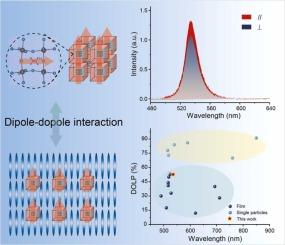Cation Dependent Linear Dichroism in PL Spectra of Self-assembled Perovskite Nanoparticle Film and Nanoparticle-Liquid Crystal Mixtures
IF 17.1
1区 材料科学
Q1 CHEMISTRY, PHYSICAL
引用次数: 0
Abstract
Self-assembly films formed by perovskite nanoparticles (NPs) exhibit fascinating collective assembly phenomena, but the in-depth description is still lacking. Here, three perovskite APbBr3 NPs, where A+ includes Cs+, MA+, and FA+, with similar size wrapping with various ligands, are used as model materials. The degree of linear polarization (DOLP) strongly depends on the aggregation of the NPs. All colloidal solutions exhibit non-polarized luminescence, whereas the DOLP of APbBr3 films range from ~0% to 10%. This can be attributed to the dipole-dipole interaction resulting from lattice distortion, imperfect shape, as well as the ligand features. Accordingly, the dipole of a NP can also interact with the dipole of liquid crystal molecules, resulting in a centimeter-scale device comprising the mixture of NPs and liquid crystal with DOLP of 50%. Our work highlights the potentials of using dipole-dipole interaction to construct NPs into large-scale structures with controllable collective optical phenomena, particularly offering a new method for linearly polarized emission.

自组装钙钛矿纳米颗粒薄膜和纳米颗粒-液晶混合物PL光谱中的阳离子依赖线性二色性
由钙钛矿纳米粒子(NPs)形成的自组装膜呈现出迷人的集体组装现象,但缺乏深入的描述。本文采用三种钙钛矿APbBr3 NPs作为模型材料,其中A+包括Cs+、MA+和FA+,它们被各种配体包裹的尺寸相似。线性极化(DOLP)的程度很大程度上取决于NPs的聚集。所有胶体溶液均表现出非极化发光,而APbBr3薄膜的DOLP在~0% ~ 10%之间。这可以归因于晶格畸变、不完美的形状以及配体的特征所导致的偶极子-偶极子相互作用。因此,NP的偶极子也可以与液晶分子的偶极子相互作用,从而形成由纳米粒子和液晶混合物组成的厘米级器件,DOLP为50%。我们的工作强调了利用偶极-偶极相互作用将NPs构建成具有可控集体光学现象的大尺度结构的潜力,特别是提供了一种线性偏振发射的新方法。
本文章由计算机程序翻译,如有差异,请以英文原文为准。
求助全文
约1分钟内获得全文
求助全文
来源期刊

Nano Energy
CHEMISTRY, PHYSICAL-NANOSCIENCE & NANOTECHNOLOGY
CiteScore
30.30
自引率
7.40%
发文量
1207
审稿时长
23 days
期刊介绍:
Nano Energy is a multidisciplinary, rapid-publication forum of original peer-reviewed contributions on the science and engineering of nanomaterials and nanodevices used in all forms of energy harvesting, conversion, storage, utilization and policy. Through its mixture of articles, reviews, communications, research news, and information on key developments, Nano Energy provides a comprehensive coverage of this exciting and dynamic field which joins nanoscience and nanotechnology with energy science. The journal is relevant to all those who are interested in nanomaterials solutions to the energy problem.
Nano Energy publishes original experimental and theoretical research on all aspects of energy-related research which utilizes nanomaterials and nanotechnology. Manuscripts of four types are considered: review articles which inform readers of the latest research and advances in energy science; rapid communications which feature exciting research breakthroughs in the field; full-length articles which report comprehensive research developments; and news and opinions which comment on topical issues or express views on the developments in related fields.
 求助内容:
求助内容: 应助结果提醒方式:
应助结果提醒方式:


